- Richard Williams, Bartlett School of Graduate Studies, UCL, London, UK.
- Dr Homeira Shayesteh, Bartlett School of Graduate Studies, UCL, London, UK.
- Dr Ljiljana Marjanovic-Halburd, Bartlett School of Graduate Studies, UCL, London, UK.
Abstract
This study explores perceptions of BIM in the FM community and attempts to highlight real world issues that facility managers have faced while using BIM. The findings from the self-administered online survey and personal interviews suggest that BIM has the potential to bring data acquisition benefits to a great number of FM professionals. However, due to a lack of best practice and guidelines it is unclear exactly how BIM should be used for FM and that a lack of evidence of BIM for FM cost savings is a barrier to adoption. Moreover, many facility managers lack the necessary skills to use BIM for FM, and this, combined with a reactive culture, means that facility managers are in danger of not being treated as valuable stakeholders in BIM projects. There is a misconception that BIM can supply FM data with little effort, when in reality facility managers must work hard to acquire the data they need. Finally, it seems that the success of BIM for FM hinges not only technology and information exchange, but also collaborative working practices and well defined processes, highlighting the fact that BIM for FM truly requires a fusion of people, process and technology.
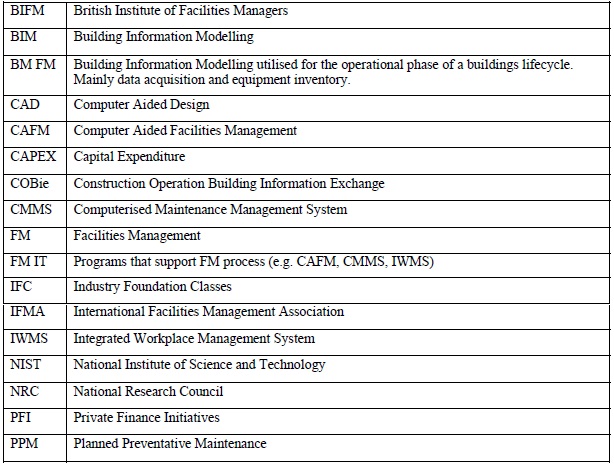
Introduction
“BIM is something that Facilities Management must engage with, and that engagement must begin as soon as possible” (BIFM, 2012). Building Information Modelling (BIM) is a managed approach to the collection and exploitation of information across a project (GCCG, 2011). Central to BIM is a 3D computer model that contains graphical and non-graphical information about design, construction and operation of an asset. BIM is not just a tool or a solution, or an “out-of-the-box” product, but rather value-creating collaboration, underpinned by 3D models and intelligent structured data requiring new processes and new channels of communication (BIM Task group, 2012; Teicholz, 2013). Consequently, BIM is a fusion of process, technology and culture (Figure 1).

Many are hailing BIM as the solution to a great many efficiency challenges in the construction industry, with change orders and requests for information being reduced to near-zero figures (AWCI, 2009). Through these efficiencies, it is suggested that BIM could help to achieve £1-2.5bn pa savings in the construction phase if extended to all major projects in the UK (GCCG, 2011).
Although it’s estimated that BIM can achieve circa 20% Capital Expenditure (CapEx) savings, “the largest prize for BIM lies in the operational stages of the project life-cycle” (BIM Task Group, 2013). The on-going costs of building operations and maintenance (O&M) far exceed the initial capital outlay of design and construction (Cotts et al, 2010), and ineffective facility handovers and the loss of essential information can dramatically increase these costs (Sabol, 2013). It is suggested that BIM for FM could be a solution to these problems, providing an integrated store of feature rich data that can be handed over to owners and facility managers throughout the lifecycle of a building (Sabol, 2013), improving O&M performance, training, and extending equipment life (Foster, 2012).
Although the FM community is becoming increasingly aware of BIM, there is a perception that FM has been slow to engage in its development, and that facility managers are not exactly sure how BIM can be used for FM effectively (BIFM, 2012). Collaboration between design, construction and FM teams is fundamental for the success of BIM for FM (NBS, 2013), and yet there is a perceived gap in the value that FM brings to the built environment, construction does not understand FM, and there is a language gap (BIFM, 2012). Facility managers are only just beginning to implement BIM for FM, and processes, software and standards are in relatively early stages of development (Teicholz, 2013). For BIM to be useful it must integrate with FM software (Teicholz, 2013), such as Computer Aided Facilities Management (CAFM), but there are potential barriers to this. Firstly, there are issues around data exchange and interoperability (BIFM, 2012), and secondly it’s not certain that all facility managers use FM software in their operations.
Literature Review
Information is the lifeblood of Facilities Management (FM) (Atkin, 2009), as it requires a vast amount of information to operate facilities efficiently and effectively (Teicholz, 2013; Wang et al, 2013; Janus, 2012). Traditionally, the majority of building information has been stored as paper documents, supplied to facility managers after a building is in operation, sometimes months after handover (Teicholz, 2013). Gathering essential FM information at the end of a new build or refurbishment project is expensive as most of the information has to be recreated and, for new builds, it can take up to three years to get as-built information after the financial close out of a project (East, 2013a). NIST (2004) report suggests that “an inordinate amount of time is spent locating and verifying specific facility and project information from previous activities” and that valuable building documentation is not routinely provided to operators. As a result, “much valuable data associated with the design, construction, and operation of a facility is lost during its life span” (NRC, 1983), with an estimated cost of $15.8 billion, the majority of which is in the operation and maintenance phase NIST (2004) (Figure 2).

A key objective of the BIM process is to enable Stakeholder’s to access the information they need when they need it (Open BIM, 2012). The construction industry has been slow in adopting standards for information storage and exchange (CRC, 2007), and a wide variety of programs used by architects and engineers makes exchanging models difficult (Bergin, 2012). Consequently, Industry Foundation Classes (IFC), a non-proprietary open global standard, have been designed to create a universal language for the built environment and are registered with ISO as a publicly available specification, PAS 16739. It seems that there is uncertainty about the status and capability of IFC as a communication protocol (Open BIM, 2012).
In the UK, PAS 1192-2 is a guideline for information exchange and collaboration between design, engineering and construction, seeking to promote interoperability across the supply chain. UK government projects that use these guidelines will review and approve a supplier’s ability to meet the information exchange requirements of the government client pre and post contract.
Despite the more attractive visual promises of BIM it seems that the need for graphical data reduces over a building’s lifetime (Figure 3) and FM is more concerned with equipment inventory, and how CAFM/ CMMS can utilise this information for effective utilisation. It’s important to find out whether Facility Managers are using CAFM systems and what these are being used for, and in light of the fact that data acquisition is a significant hurdle to the use of FM software, we must discover how difficult it is for facility managers to acquire data and how long it takes them to populate this data.
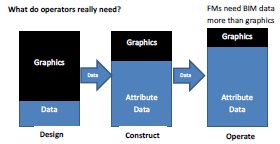
Critical to the success of BIM and CAFM integration is an accurate specification of the BIM data that is required by operations, and interoperability of BIM and FM software (Teicholz, 2013), Currently, there is a great deal of focus on Construction Operations Building Information Exchange (COBie), an exchange format developed by the Corps of Engineers Research Lab for operational data handover (Sabol, 2013). COBie is a simplified non-geometric subset of IFC (NBS, 2013) and can be created in IFC format or Excel (Sabol, 2008) (Figure 4).
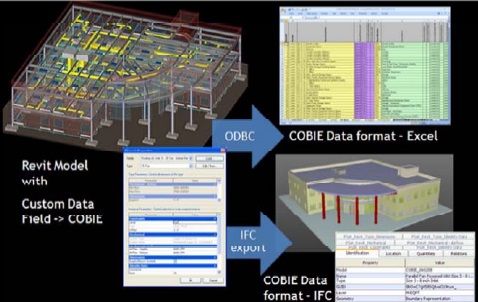
Collaboration between design, construction and FM teams has been identified as a critical element for the success of BIM for FM, and the early involvement of facility managers in the design process is an important aspect of this. Although BIM is said to be the catalyst that enables collaboration it is not clear that there is evidence to support this. There are mixed collaborative successes in the case studies, but more worryingly there are suggestions that FM has been reluctant to contribute to the design stage, feeling more valuable in the later stages of the lifecycle.
Collaboration depends on information exchange between disparate IT systems and BIM authoring platforms. Consequently, interoperability and open standards are fundamental to success. COBie appears to be a valid interim exchange format, while the industry gets up to speed with IFC, but it is not widely adopted or without its critics, and case studies reveal that it can take an extremely long time to manage data in a COBie format. It seems that we could be replacing one laborious process, that of acquiring data after handover, for another.
Open standards are also questionable as there are a wide variety of classification systems that can be confusing for the implementer. There is also disagreement between design, construction and FM as to the best classification systems to use. Surveys suggest that the adoption of BIM for FM is not widespread and that people do not trust what they hear about BIM (NBS, 2013a). There is certainly a lack of hard evidence and best practice case study examples to prove the benefits of BIM for FM. Some case studies are anecdotal without presenting proven tangible benefits, and this may not be enough to persuade owners to invest (Lane, 2013).
For those that have attempted BIM implementation, we need to establish whether the uses, benefits, and challenges identified in the literature are in fact relevant. This will enable us to critically appraise the current state of BIM for FM and make recommendations for improvement. The aim of this study is to identify the key opportunities and challenges for full FM participation in BIM development and application by:
- Establishing the current take-up and awareness levels of CAFM and BIM in the FM community.
- Identifying the drivers and barriers of full FM participation in BIM development and application.
- Examining CAFM and BIM data exchange compatibility.
- Investigating whether BIM is encouraging collaboration between design, construction and FM teams.
- Recommending ways to improve BIM for FM integration.
Methodology: Triangulation of mixed methods
Since the aims of the research were to understand the views of FM professionals in a wider context, as well as to explore individual experiences in depth, a mixed methods approach was adopted.
Survey: quantitative method
A self-administered online survey was used to understand and describe the opinions and attitudes of a larger global sample, with the intent of deriving comparable data across subsets to identify similarities and differences.
The survey presented forty questions across three domains: Demographics, CAFM and BIM for FM. Basic demographic questions were used to collect data about respondents and their organisations, allowing the data to be analysed in subsets. Custom-designed measurement questions were created to answer investigative questions and were developed using themes identified in the literature and other surveys such as GEFMA-IFMA (May and Williams, 2012) survey questions for IT in FM. Questions were worded using a simple shared vocabulary that would be understood by the FM community and minimise ambiguity.
Many of the survey questions used multiple rating list Likert scales, asking the respondent to rate a list items significance in relation to the question, with 5 being very significant, and 1 being very insignificant. Likert scales produce interval data, and are potentially more reliable and provide a greater volume of data than other scales. For each question, weighted averages were used to rank answers in order of significance across the entire response sample for that question.
The formula for calculating weighted average is:

KwikSurveys was used to distribute the survey online via LinkedIn, a professional networking site, and members of FM interest groups, such as BIFM and IFMA, were asked to participate. A discussion was started in each of the FM groups requesting participants for the study, and an overview of the research and a link to the online survey was provided. LinkedIn was a successful method of distributing the survey as it provided access to a global FM community with participants from a wide variety of industries and backgrounds, and enabled the researchers to build relationships with people that were active in BIM for FM discussions and enlist these as participants for personal interviews. The Survey data were analysed using descriptive statistics.
Personal interviews: qualitative method
In-depth qualitative personal interviews were carried out with a smaller sample of FM professionals and explored particular aspects of BIM for FM in more detail. A semi-structured interview schedule developed using literature themes and preliminary survey results, was used to guide the interview.
Five interviews were conducted to explore individual experiences of the challenges and opportunities of using BIM within FM. As with the survey, participants were contacted via LinkedIn FM interest groups. The interview data were analysed using a thematic analysis approach whereby data were coded to create shorter phrases to summarise the focal points. These codes were then collated into overarching themes to identify similarities and differences across data.
The interviews focused on BIM for FM themes (Figure 5) that were identified in the literature, and also featured heavily in the survey data.
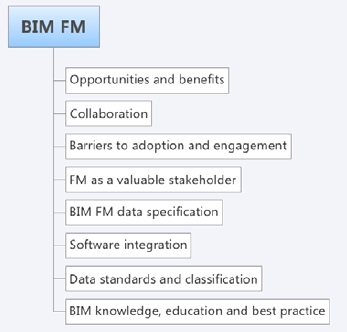
Findings and Discussion
In total 42 complete questionnaires were returned. The weighted averages for each question are presented in Appendix 1.
The survey was available globally, but the majority of respondents (47%) were from the UK. Our survey and interview findings confirm that CAFM is mainly used for maintenance and asset management (Figure 6), as indicated by FMA (2012) and May and Williams (2012). Facility Managers that use CAFM for asset management and maintenance are less concerned with graphical data and are more concerned with structured asset data (NBS, 2012; Teicholz, 2013a).
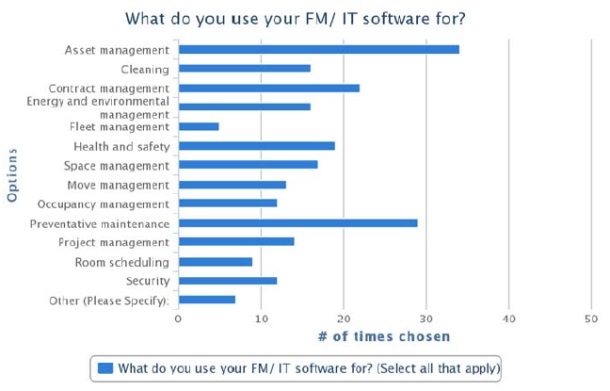
Culture (Keller, 2012), length of implementation (May and Williams, 2012) and cost (Madritsch and May, 2009) were identified in the literature as the main barriers to CAFM adoption, and our survey findings support this. Data acquisition has been identified as a major challenge for CAFM (Madritsh and May, 2009; Redlein 2012; Abel and Lennerts, 2005), and our survey findings are in agreement with this. Our findings suggest that many facility managers (45.95%) find it difficult to acquire the data for their systems (Figure 7), and that it can take a long time to populate the data (Figure 8).

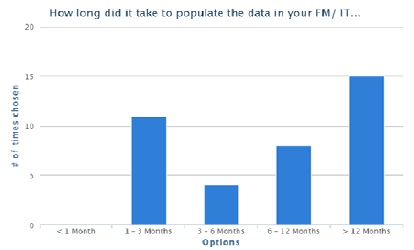
BIM for FM Adoption, uses and challenges
The survey findings support Teicholz (2013) and Foster (2012) and suggest that BIM for FM is primarily being used for asset management and maintenance and benefits FM through improved inventory and equipment management, availability of information before commissioning, and a reduction in data acquisition time and cost.
Facility managers require a data-centric repository of location asset information from BIM, and the effective use of BIM for FM hinges on who, what and how data is collected. It is critical that facility managers have the skills to specify data (Teicholz, 2013), yet several interviewees suggest that this is a major challenge. Interviewees indicated that facility managers are reactively accepting the data that it is available in BIM instead of proactively demanding the data they need to make their roles more effective. Our interview findings also suggest that this reactive approach to data may partly have been caused by software vendors suggesting that appropriate data will be available in BIM and that this can be easily transferred to CAFM systems with little effort.
Our findings also suggest that a major barrier to FM engagement is that facility managers are not being involved in the early phases of a buildings lifecycle and this will undoubtedly negatively affect the facility managers ability to specify the data that needs to be collected and result in a largely reactive approach.
Moreover, BIFM (2012) has identified training as a key aspect of BIM for FM success. Our interview findings also suggest that education and training is a barrier to the adoption of BIM for FM and that there is a shortage of facility managers with BIM skills. Interviewees suggested that a new breed of FM is required, BIM for FM specialists, specialists with the appropriate knowledge to contribute effectively.
We also found that although many facility managers believe BIM is important for FM (Figure 9), only 35.1% have had exposure to BIM. A BIM4FM (2013) survey indicates that 65% of Facility Managers are aware of BIM and how it can be used for the built environment, but fails to explore the depths of this awareness. Our findings indicate that less than half (40.5%) know enough about BIM to assess its impact on FM, signifying that although facility managers may be aware of BIM they lack the knowledge to evaluate it.
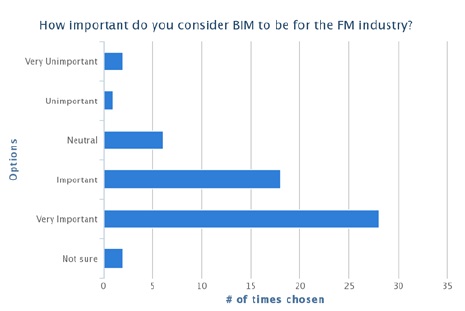
The survey findings support [Sabol 2013, BIFM2012] revealing that the main barriers for BIM for FM engagement and adoption are ‘owners and operators lacking knowledge of BIM’ and ‘no best practice or guidelines’. Interviewees also noted that most case studies are anecdotal about opportunities and benefits, and fail to highlight the challenges that people are facing, an issue raised by Lane (2013).
Several interviewees responded that the adoption of BIM for FM depends heavily on owners having knowledge of BIM and its operational benefits, since it is often the owners that are paying for BIM. Interviewees also suggested that few clients really understand the long-term operational savings, due to a Capex/ Opex divide and a lack of hard evidence of cost savings, a problem highlighted by Lane (2013). Interview findings suggested that the costs can push owners to evaluate BIM for FM out of projects, and a lack of credible evidence can only exacerbate this problem.
If owners are to be convinced of the benefits of BIM for FM then facility managers must also be convinced of its merits, and actively push for BIM to be included in the operational phase. However, our interview findings suggested that FM is a reactive industry, made so by ineffective past handovers, and that facility managers are often cautious of new technology and reluctant to adopt new working practices. The lack of real-world hard evidence of BIM for FM could be preventing facility managers from engaging and promoting BIM to owners.
Collaboration between design, construction and FM teams
Collaboration between design, construction and FM teams is fundamental for the success of BIM for FM, changing the deeply ingrained culture of silos that have prevailed across industries (NBS, 2013). However, our findings suggest that a lack of collaboration between design, construction and FM is a major challenge. Moreover, although silos may be breaking down between design and construction, BIM is building a double walled silo for facility managers in the form of a language and knowledge gap.
Wang et al (2013) suggest that BIM is the tool for bringing FM into the design phase. However, evidence in this study suggests that this is yet to be achieved. Our interview findings suggest that on some BIM projects facility managers have not been viewed as valuable stakeholders and have not “had the opportunity to add meaningful value to the design and refurbishment of facilities” (BIFM, 2012). BIFM 2012 suggests that “there is still a gap in the perceived value that FM can bring” and interview findings confirmed this. Educating design and construction about the merits of FM could help to elevate the perception of FM from “security and cleaning supervisors” to a crucial role that can, with the correct knowledge base, collaborate with design and construction and use their knowledge to ensure operational factors are considered early on.
Integration: barriers and challenges
Becerik-Gerber et al, 2011 suggest that BIM must integrate with FM software to add real value, and in support of this the majority of our respondents thought it important or very important for BIM to integrate with FM software (Figure 10).
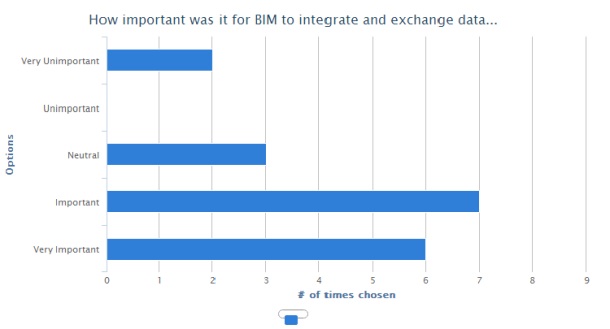
Although much of the literature focused on COBie as the primary form of data exchange, NBS (2013a) suggested that only 15% of people using BIM are producing COBie. Our findings support this and suggest that COBie is not a dominant form of data exchange, as proprietary or custom methods are also being used (Figure 11). East (2013a) states that COBie simplifies the work required to capture and record project handover data. However, interview findings suggest it takes a great deal of time for designers and contractors to enter this information, often manually, and this is causing BIM for FM to be evaluated out of projects. This supports Grady (2013) and Beatty et al (2013) in their argument that COBie data can take a very long time to collect and is often not used.

Barriers to information exchange
Product naming standards and definitions were identified as a barrier to integration, with 31.25% suggesting a significant barrier and 12.50% suggesting a very significant barrier. Every respondent that had used COBie said that product naming standards were a significant or very significant barrier to information exchange.
Case studies reveal that it can take 2 years to acquire data using COBie (Beatty et al, 2013), and this suggests that while COBie may provide a structured format for data, and encourage a collaborative approach to data acquisition, it does not seem to be simplifying data collection. Our interview findings indicate that it is not the data format itself that is the problem, but rather the way the data is classified and how it is specified that is causing heated debate. Interview findings suggested that data is being collected and classified as unitised items, instead of assemblies, and is forcing designers and construction personnel to use workflows that are unnatural to them, an issue raised by NBS (2012) and Grady (2013).
One of the interviewees, who had not used COBie for information exchange, suggested that integration had been a great success, with a large number of disparate IT systems being integrated. Critical to this success was people management, to encourage collaboration between Facility Managers and vendors, and technical skills, to ensure the data was collected and classified appropriately. In this case two Facility Managers with different skillsets worked together to achieve this success, suggesting that perhaps FM teams of the future will require members that are comfortable with people, process, and technology, the three crucial BIM elements identified by MacDonald (2011).
Conclusion
The aims of the research were to understand the views of FM professionals in a wider context, as well as to explore individual experiences in depth. The discussion considered the findings in relation to the literature and highlighted some key opportunities and challenges for FM participation in BIM. Given the large number of facility managers using CAFM, BIM has the potential to bring data acquisition benefits to a great number of FM professionals. However, although facility managers are aware of BIM, few have used it, and it is unclear exactly how to use BIM for FM effectively. Facility managers and owners lack the knowledge to evaluate BIM, many case studies are anecdotal and fail to highlight challenges, and there is a lack of best practice and guidelines.
Facility managers need non-graphical asset data from BIM, and it is critical for them to have the skills to specify the data they need. Data specification is a major challenge and many facility managers are adopting a reactive approach, expecting BIM to supply the data with very little effort. There is no BIM easy button, however, and proactive effort by BIM educated FM professionals is required.
There is a lack of hard evidence of operational savings and this creates two problems for BIM for FM take-up. Firstly, facility managers are cautious and need evidence before engaging. Secondly, adoption of BIM depends heavily on owners appreciating its benefits, but a Capital expenditure (Capex)/ Operational expenditure (Opex) divide and lack of hard evidence can cause BIM for FM to be evaluated out of projects.
Although COBie dominates the literature it does not appear to be the dominant form of data exchange. COBie has many critics, but it seems that it is not the data exchange format that is the issue but classification and data specification. Regardless of exchange formats, software integration success can be achieved using a collaborative approach and FM teams that have both people and technical skills.
The results of this study suggest that the success of BIM for FM hinges not only technology and information exchange, but also collaborative working practices and well defined processes, highlighting the fact that BIM truly requires a fusion of people, process and technology.
References
Abel, J. and Lennerts, K. (2005) Where does CAFM really help? Current fields of application and future trends according to system users, [Online], Available: http://www.irbnet.de/daten/iconda/06069014308.pdf, [Accessed: 1st July 2013]
Atkin, B. (2009) Total Facilities Management, 3rd Edition, Chichester: Wiley-Blackwell
AWCI (2009) BIM: Understanding and Operating in a New Paradigm, [Online], Available: http://www.awci.org/pdf/bim.pdf, [Accessed: 7th June 2013]
Becerik-Gerber, B. Jazizadeh, F., Li, N. and Calis, G. (2011) Application areas and data requirements for BIM-Enabled Facilities Management, Journal of construction engineering and management
Beatty, R., Eastman, C., Kim, K. and Fang, Y (2013) Texas A&M Health Science Center, [Case Study], in Teicholz, P. ed. BIM for Facility Managers, 1st Edition, New Jersey: John Wiley & Sons, pp. 164-184
Bergin, M. (2012) A brief history of BIM, [Online], Available: http://www.archdaily.com/302490/a-brief-history-of-bim/, [Accessed: 1st July 2013]
BIFM (2012) BIM and FM: Bridging the gap for success, [Online], Available: http://www.bifm.org.uk/bifm/filegrab/3bim-fm-report-bridgingthegapforsuccess.pdf, [Accessed: 10th May 2013]
BIM Task Group (2012) A report for the government construction client group: Building Information Modelling (BIM) Working Party Strategy Paper, [Online], Available: http://www.bimtaskgroup.org/wp-content/uploads/2012/03/BIS-BIM-strategy-Report.pdf, [Accessed: 1st July 2013]
BIM Task Group (2013) Frequently asked questions, [Online], Available: http://www.bimtaskgroup.org/bim-faqs/, [Accessed: 1st July 2013]
Cabinet Office (2012) Government Construction Strategy, [Online], Available: https://www.gov.uk/government/uploads/system/uploads/attachment_data/file/61152/Govern ment-Construction-Strategy_0.pdf, [Accessed: 16th May 2013]
Cabinet Office (2012a) Government Construction Strategy: One year on Report and Action Plan Update, [Online], Available: https://www.gov.uk/government/uploads/system/uploads/attachment_data/file/61151/GCSOne- Year-On-Report-and-Action-Plan-Update-FINAL_0.pdf, [Accessed: 16th May 2013]
Cabinet Office (2012b) Government Soft Landing Policy, [Online], Available: http://www.ciob.org/sites/ciob.org.uk/files/the-government-soft-landings-policy-5.pdf, [Accessed: 1st June 2013]
Cotts, D., Roper, K and Payant, R (2010) Facility Management Handbook, 3rd Edition, USA: AMACOM, Kindle Edition
CRC (2007) Adopting BIM for facilities management: solutions for managing the Sydney Opera House, [Online], Available: http://www.constructioninnovation.info/images/CRC_Dig_Model_Book_20070402_v2.pdf, [Accessed: 1st July 2013]
East, W.E. (2013a) Construction Operations Building Information Exchange (COBie), [Online], Available: http://www.wbdg.org/resources/cobie.php, [Accessed: 1st July 2013]
FMA (2012) UK Annual CAFM Survey Results 2012, [Online], Available: http://www.swg.com/ourwhitepapers/, [Accessed: 1st July 2013]
Foster, B. (2012) Using real-time CMMS asset data capture during construction to improve Facilities Management, Journal of Building Information Modelling, pp.16-17
GCCG (2011) Report for the Government construction client group: Building Information Modelling (BIM) Working Party Strategy Paper, [Online], Available: http://www.bimtaskgroup.org/wp-content/uploads/2012/03/BIS-BIM-strategy-Report.pdf, [Accessed: 7th June 2013]
Grady, J. (2013) Epic BIM: COBie is dead, [Online], Available: http://www.epicbim.com/2013/05/cobie-is-dead.html, [Accessed: 6th July 2013]
IFMA (2011) Profiles 2011 Salary and Demographics Research Report, [Online], Available: http://www.ifma.org/marketplace/promotional-opportunities/member-demographics, [Accessed: 1st July 2013]
Janus, K (2012) The relationship between FM and IT, in: May, M. and Williams, G. eds. The Facility Managers Guide to Information Technology, IFMA, pp. 1-3.
Keller, C. (2012) CAFM/ IWMS — Balancing technology, processes, and objectives, in Teicholz, E. ed. Technology for Facility Managers: The impact of Cutting-Edge Technology on Facility Management, John Wiley and Sons
Lane, T. (2013) Tune in to BIM for FM, [Online]. Available: http://www.building.co.uk/bim/bimin- practice/tune-in-to-bim-fm/5055672.article, [Accessed: 1st July 2013]
Macdonald, J. (2011) BIM- Adding value by assisting collaboration, [Online], Available: http://www.academia.edu/1767394/BIM_- _ADDING_VALUE_BY_ASSISTING_COLLABORATION, [Accessed: 1st July 2013]
Madritsch, T. and May, M. (2009) Successful IT implementation in facility management, Facilities, Vol.27, No.11/12, pp.429-444
May M. and Williams, G. (2012) The Facility Manager’s Guide to Information Technology, IFMA NRC (1983) A report from the 1983 Workshop on Advanced Technology for Building design and engineering, Washington, DC: National Academy Press
NBS (2012) The IFC/ COBie Report 2012, [Online], Available: http://www.thenbs.com/topics/BIM/cobie/, [Accessed: 6th July 2013]
NBS (2013) BIM for the terrified: a guide for manufacturers, [Online], Available: http://www.constructionproducts.org.uk/publications/industry-affairs/display/view/bim-forthe- terrified/, [Accessed: 6th July 2013]
NBS (2013a) National BIM Report, [Online], Available: http://www.thenbs.com/pdfs/NBSNationlBIMReport2013-single.pdf, [Accessed: 1st July 2013]
NIST (2004) Cosy analysis of inadequate interoperability in the U.S capital and facilities industry, [Online], Available: http://fire.nist.gov/bfrlpubs/build04/art022.html Open BIM (2012) Open BIM Focus: IFC/ COBie validation trial, [Online], Available: http://www.openbimnetwork.com/assets/applets/OPEN_BIM_Focus_- _Issue5_Nov_2012_FINAL.pdf, [Accessed: 1st July 2013] Redlein, A. (2012) Facility Management and IT Support, Advanced Research in Scientific Areas, Vol.3, pp.360-362
Sabol, L. (2008) Building Information Modelling and Facility Management, Design and Construction Strategies, [Online], Available: http://dcstrategies.net/files/2_sabol_bim_facility.pdf, [Accessed: 1st July 2013]
Sabol, L. (2013) BIM Technology for FM, in Teicholz, P. ed. BIM for Facility Managers, 1st Edition, New Jersey: John Wiley & Sons, pp. 17-45
Teicholz, P. (2013) BIM for Facility Managers, 1st Edition, New Jersey: John Wiley & Sons
Teicholz, P. (2013a) Owner BIM for FM Guidelines, in Teicholz, P. ed. BIM for Facility Managers, 1st Edition, New Jersey: John Wiley & Sons
Wang, Y., Wang, X., Wang, J., Yung, P. and Jun, G. (2013) Engagement of Facilities Management in Design stage through BIM: Framework and a case study, Advances in Civil Engineering, Vol.13, pp. 1-8
Appendix 1 Weighted averages for the survey questions
Question 1: Benefits of CAFM

Question 1: Barriers to CAFM adoption

Question 2: Barriers to BIM for FM engagement and adoption
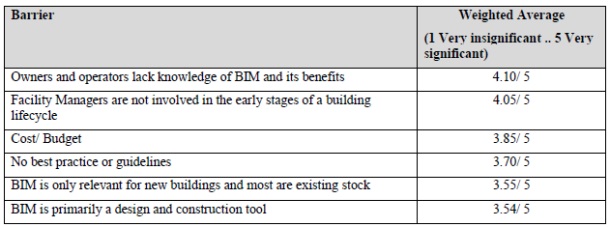
Question 3: Uses of BIM for FM

Question 4: Benefits of BIM for FM

Question 5: Main challenges of BIM for FM

Question 6: Barriers to integration and information exchange

Question 7: Barriers to collaboration

Appendix 2 Interview themes and critical aspects
